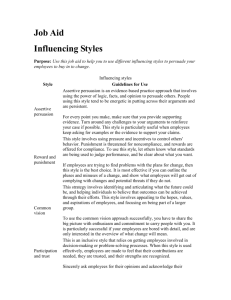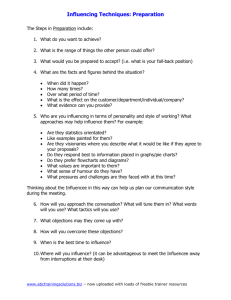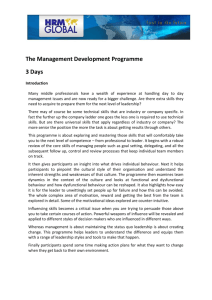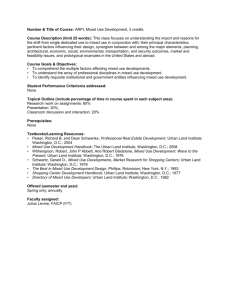Influencing Others
advertisement
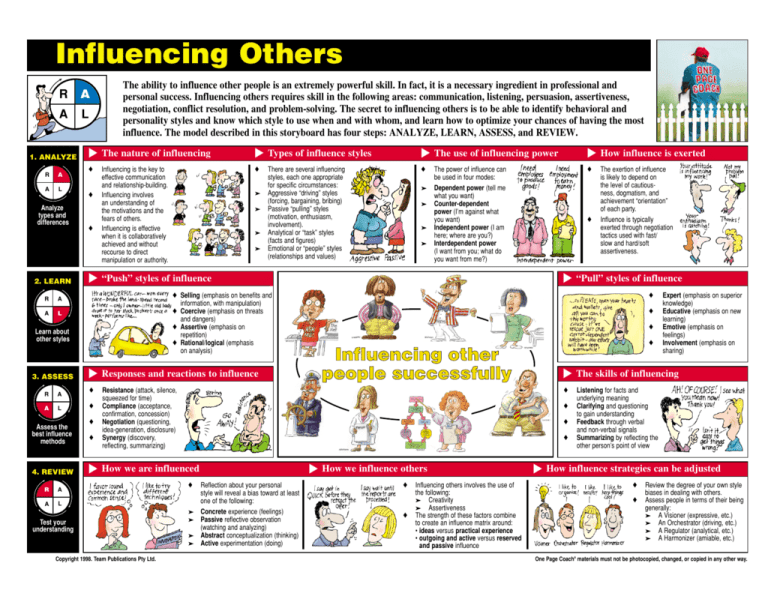
Influencing Others L Analyze types and differences 2. LEARN R A A L ♦ ♦ ▼ A ♦ A L ♦ R A A L ♦ ♦ ▼ 4. REVIEW ➤ ➤ ➤ ➤ ➤ ➤ ➤ ♦ ♦ Influencing other people successfully ♦ ♦ ♦ ♦ Copyright 1998. Team Publications Pty Ltd. ♦ ➤ ➤ ➤ ➤ Reflection about your personal style will reveal a bias toward at least one of the following: Concrete experience (feelings) Passive reflective observation (watching and analyzing) Abstract conceptualization (thinking) Active experimentation (doing) “Pull” styles of influence ♦ Resistance (attack, silence, squeezed for time) Compliance (acceptance, confirmation, concession) Negotiation (questioning, idea-generation, disclosure) Synergy (discovery, reflecting, summarizing) How we are influenced The exertion of influence is likely to depend on the level of cautiousness, dogmatism, and achievement “orientation” of each party. Influence is typically exerted through negotiation tactics used with fast/ slow and hard/soft assertiveness. ♦ Responses and reactions to influence Test your understanding ▼ ♦ The power of influence can be used in four modes: Dependent power (tell me what you want) Counter-dependent power (I’m against what you want) Independent power (I am here; where are you?) Interdependent power (I want from you; what do you want from me?) How influence is exerted ♦ ♦ Selling (emphasis on benefits and information, with manipulation) ♦ Coercive (emphasis on threats and dangers) ♦ Assertive (emphasis on repetition) ♦ Rational/logical (emphasis on analysis) R Assess the best influence methods ➤ ♦ There are several influencing styles, each one appropriate for specific circumstances: Aggressive “driving” styles (forcing, bargaining, bribing) Passive “pulling” styles (motivation, enthusiasm, involvement). Analytical or “task” styles (facts and figures) Emotional or “people” styles (relationships and values) “Push” styles of influence Learn about other styles 3. ASSESS ♦ Influencing is the key to effective communication and relationship-building. Influencing involves an understanding of the motivations and the fears of others. Influencing is effective when it is collaboratively achieved and without recourse to direct manipulation or authority. The use of influencing power ▼ A ♦ Types of influence styles ▼ A The nature of influencing ▼ R ▼ 1. ANALYZE How we influence others ♦ ♦ Influencing others involves the use of the following: ➤ Creativity ➤ Assertiveness The strength of these factors combine to create an influence matrix around: • ideas versus practical experience • outgoing and active versus reserved and passive influence ▼ L ▼ A The ability to influence other people is an extremely powerful skill. In fact, it is a necessary ingredient in professional and personal success. Influencing others requires skill in the following areas: communication, listening, persuasion, assertiveness, negotiation, conflict resolution, and problem-solving. The secret to influencing others is to be able to identify behavioral and personality styles and know which style to use when and with whom, and learn how to optimize your chances of having the most influence. The model described in this storyboard has four steps: ANALYZE, LEARN, ASSESS, and REVIEW. ▼ A ▼ R Expert (emphasis on superior knowledge) Educative (emphasis on new learning) Emotive (emphasis on feelings) Involvement (emphasis on sharing) The skills of influencing Listening for facts and underlying meaning Clarifying and questioning to gain understanding Feedback through verbal and non-verbal signals Summarizing by reflecting the other person’s point of view How influence strategies can be adjusted ♦ ♦ Review the degree of your own style biases in dealing with others. Assess people in terms of their being generally: ➤ A Visioner (expressive, etc.) ➤ An Orchestrator (driving, etc.) ➤ A Regulator (analytical, etc.) ➤ A Harmonizer (amiable, etc.) One Page Coach® materials must not be photocopied, changed, or copied in any other way.
